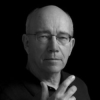Sam Abell

Sam Abell
Sam Abellis an American photographer known for his frequent publication of photographs in National Geographic. He first worked for National Geographic in 1967, and is one of the more overtly artistic photographers among his magazine peers. Sam Abell's style of photography is documentary in the sense that his major avenue, the National Geographic magazine, is a publication of record. However, his best work is known for its transcendent qualities, starting at the documentary level yet open to interpretation on an...
NationalityAmerican
ProfessionPhotographer
CountryUnited States of America
That's who comes to my workshops. I jokingly tell my students that the class could be called "Your photographs: Better."
In the last workshop I taught, a woman flew in from Thailand. She's a medical doctor in Bangkok. I asked her in her one-on-one session where she wanted photography to be in her life.Did she want a second career? Was it about earning money? Or was it art? And she said "None of those. I want photography to be serious in my life." It would be like someone wanting music, like piano playing, to be a richer, deeper, and maybe even harder experience.
I was a consultant for Kodak back in the late 80's. There were engineers there who told me that in the future, most photographs would be taken on telephones. They weren't able to do anything with that. They were engineers, not management.
It's more difficult now, to be a Geographic photographer, than it was when I came along. And it wasn't easy at that time.
My least favorite photographer to have would be myself. Someone who wanted a career at National Geographic. Because it's almost mathematically impossible to achieve that.
When assignments were over, photography continued. One of the primary reasons it did was that I wanted and needed to have fresh work. Also, it's very stimulating to be around non-professional photographers. They're the ones with the purest flame burning about their photography. I appreciate that.
First of all, I appropriate photographs.In presenting the Richard Prince photograph I tried to be as neutral as I could be. I put down the fact of it. I wanted it to be the same thing he wanted it to be, an open ended invitation to think about authorship, and who owns a created work. So I pair it with my appropriated picture.
A very big part of the life of a photograph is the afterlife.
I was asked by a student what my most significant accomplishment was at National Geographic, after thirty years, and I said that my career came to an appropriate close, and I still loved photography. Not everybody who spends their career at anything ends up fascinated and involved with it.
I think that it's workshops, honestly, that have kept me keen about photography, and about my photography. My career as a workshop photographer came while I was at the Geographic in the late 70's, and has continued consistently since then.
I can't speak for other photographers, but the photographers who went forward strongly when the so-called "official" part of their career ended, to me, were those who had taught. Teaching enriches and enlivens one's work.
Yes, there are billions more photographers, and billions more photographs every day, but who's building up a point of view? Who's photographing with intention, and whose body of work will sustain itself and survive?
This might seem off the track, but an interesting thing to me that others could talk about better than I, but one of the growth areas in photographic education has been the so-called slow photography.
I now want to be a photographer of my time, and our common culture.